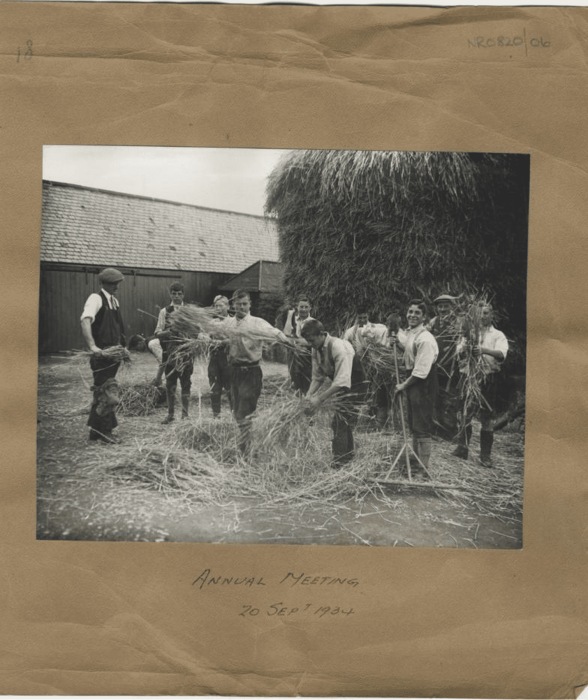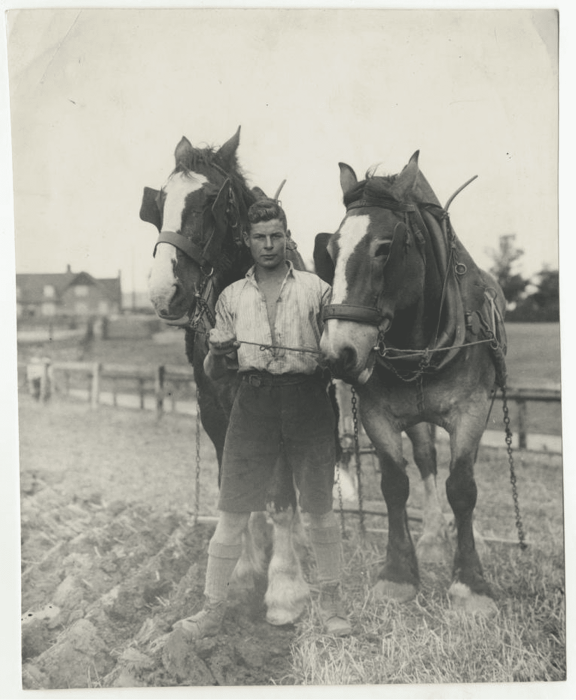Photographs of Netherton School Farm, 1934 and about 1950
Reference: NRO 00820/O/06, 12
Suggested age groups: KS2, KS3, KS4, lifelong learners
Subject areas: History, Literacy, Art, Technology
CONTEXT
At the beginning of the nineteenth century, a child who committed a crime was tried in the same court as an adult. If the judge or magistrate sentenced them to prison, they would be sent to the same prison as adult criminals.
Some campaigners, such as Mary Carpenter, argued that children should be kept away from adult criminals so that they did not learn bad habits from them. She also said that children should be given training and be allowed to play.
Pressure from campaigners led to Parliament passing the Reformatory Schools Act in 1854. The Act allowed reformatory schools to be set up and for them to be officially inspected. Magistrates could send children under the age of 16 to these schools, instead of to prison.
A reformatory school was set up in Newcastle in 1853, just before the Act passed through Parliament. The school was moved to Netherton, near Morpeth, in 1857. In 1933 Netherton became an “Approved School”, which replaced reformatories and industrial schools. Netherton continued to be a residential school for boys well into the 1980s.
The aim of a reformatory was to educate boys who had committed a criminal offence and to train them so that they would be useful citizens in the future. The boys’ lives involved working on the school farm and workshops, where they were taught various skills. Many of the local farmers purchased carts, implements and gates from the reformatory as well as employing the boys as casual labour.
ACTIVITIES
ACTIVITY 1
Background
The aim of a reformatory was to educate boys who had committed a criminal offence and to train them so that they would be useful citizens in the future. The boys’ lives involved working on the school farm and workshops, where they were taught various skills. Many of the local farmers purchased carts, implements and gates from the reformatory as well as employing the boys as casual labour.
SEE
See: What are the boys doing in the photographs?
See: Who else is in the photographs with the boys?
See: What else is in the photographs?
See: What age do the boys look?
See: What types of clothes are they wearing?
THINK
Think: Are the boys doing work that would have traditionally been done by boys during this time period?
Think: What can we learn about the conditions at Netherton from these photographs?
Think: What other types of work and activities would the boys have done?
Think: Who do you think took the photographs?
Think: Why do you think they took the photographs?
Think: What do you think the annual meeting was?
Think: What do you think the horses were used for?
Think: Are the photographs posed or candid?
DO
Do: What types of conversations do you think the boys might have had while they worked? In small groups, write a script of the conversations that might have taken place and then perform it.
Do: What are some of the activities that you do every day? Take photographs to document your daily life.
Do: Imagine you are one of the boys at Netherton. Write a letter home to tell your family about what you have done that day.
Resources
ACTIVITY 2
Background
By the beginning of the twentieth century, photography was well on its way to becoming the visual language it is today and was becoming increasingly more available to more people. In the later nineteenth century, photography became more popular, and inventions like the Kodak #1 camera (1888) made it accessible to the upper-middle-class consumer; the Kodak Brownie camera, which cost far less, reached the middle class by 1900.
SEE
See: What colour are the photographs?
See: How clear are the photographs?
THINK
Think: How were photographs taken during the early twentieth century?
Think: How were photographs developed during the early 20th Century?
Think: How long would it have taken to take the photograph?
Think: Why might some parts of the photographs be blurry?
Think: How do these photographs compare to photographs we can take today? List some of the similarities and differences.
DO
Do: Using iPads or something similar, take photographs of the room you are in. Can you edit these photographs to make them look similar to the photographs from Netherton? How does changing the colour affect the photograph?
Do: What do you think someone in 100 years’ time could learn about the room from looking at your photograph?
Do: Create a model of a Kodak Box Brownie camera. How does this look different to a camera you would use today?
Resources
ACTIVITY 3
Background
At the beginning of the nineteenth century a child who committed a crime was tried in the same court as an adult. If the judge or magistrate sentenced them to prison, they would be sent to the same prison as adult criminals. Pressure from campaigners led to Parliament passing the Reformatory Schools Act in 1854. The Act allowed reformatory schools to be set up and for them to be officially inspected. Magistrates could send children under the age of 16 to these schools, instead of to prison.
SEE
See: How were child criminals tried and sentenced in the early nineteenth century?
See: Why did campaigners want to keep child criminals separate from adult criminals?
See: What did Mary Carpenter say children should be given, rather than being sent to prison with adults?
See: When was the Reformatory Schools Act passed?
See: Who could be sent to reformatory school?
THINK
Think: What were Mary Carpenter’s education principles and methods?
Think: How were Mary Carpenter’s education principles and methods different to the general principles of the time?
Think: What was the purpose of reformatory school?
Think: What were the conditions like in reformatory school?
Think: What were the rules and regulations of reformatory school?
Think: What would the children have spent their time doing at reformatory school?
DO
Do: In small groups, debate whether or not introducing reformatory schools was the right way to punish child criminals.
Do: Using the information provided by the Children’s Homes website, draw up a plan of Netherton.
Resources
OTHER ONLINE RESOURCES
The National Archives website, page on “Victorian Children in Trouble”: https://www.nationalarchives.gov.uk/education/resources/victorian-children-in-trouble/
Infed.org website, page about Mary Carpenter and her ideas about education:
https://infed.org/mobi/mary-carpenter-reformatory-schools-and-education/
Northumberland Archives blog, page about Netherton Reformatory:
https://northumberlandarchives.com/2015/03/30/netherton-reformatory-one-mans-first-world-war-story-david-eckstein/
Children’s Homes website, page with history of Netherton Reformatory:
http://childrenshomes.org.uk/NethertonRfy/
Children’s Homes website, page with general information about reformatories: http://childrenshomes.org.uk/Rfy/
Children’s Homes website, page with model rules and regulations (1890):
http://childrenshomes.org.uk/rules/Rfy.shtml



